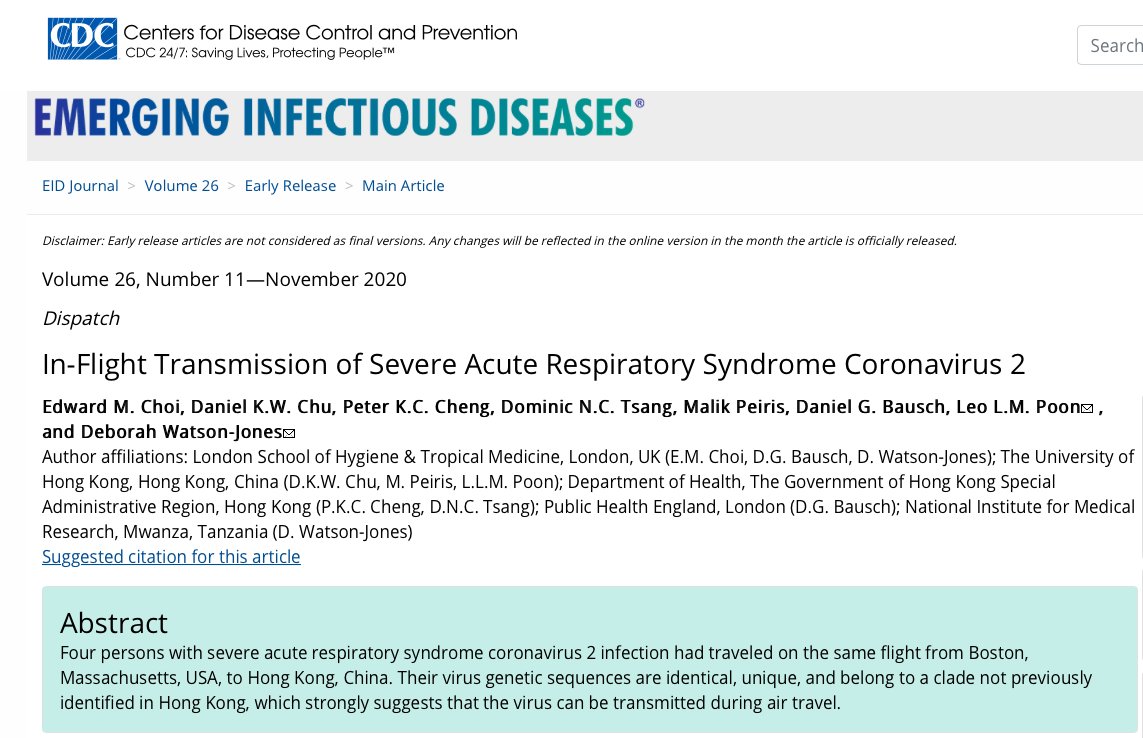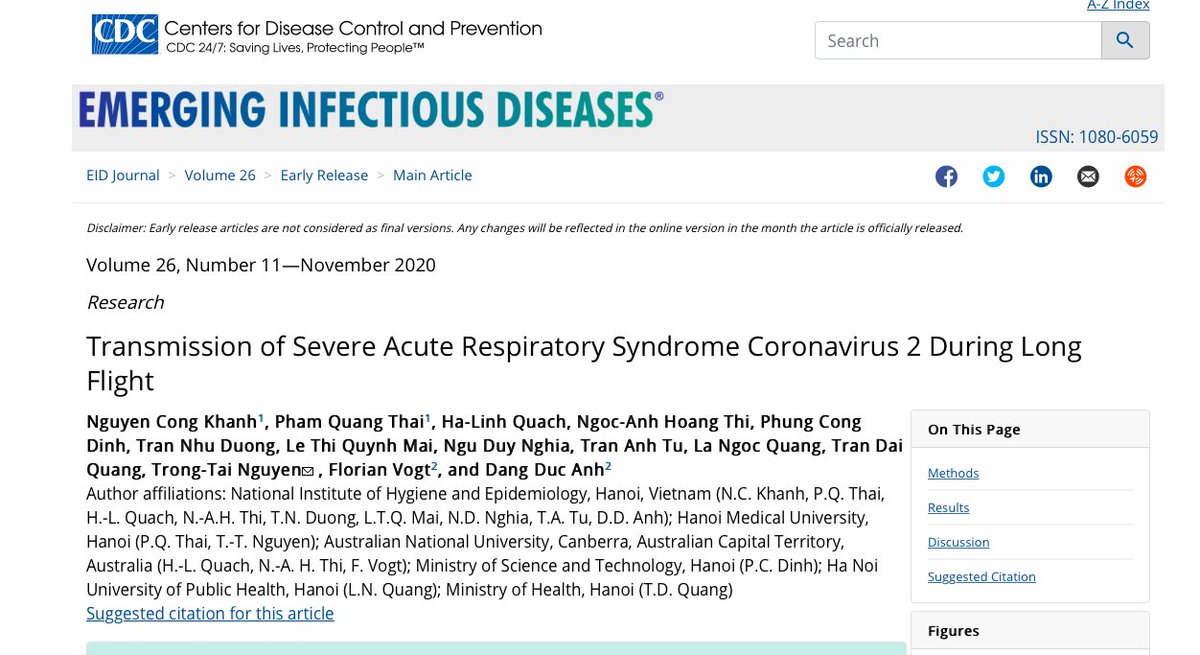Thread
Are flights "safe"?
This is a question that I have been asked dozens of times by friends/colleagues/media
This week, @cdc_eidjournal published a couple of reports of #covid19 transmission on flights
- https://wwwnc.cdc.gov/eid/article/26/11/20-3299_article
-">https://wwwnc.cdc.gov/eid/artic... https://wwwnc.cdc.gov/eid/article/26/11/20-3254_article">https://wwwnc.cdc.gov/eid/artic...
Are flights "safe"?
This is a question that I have been asked dozens of times by friends/colleagues/media
This week, @cdc_eidjournal published a couple of reports of #covid19 transmission on flights
- https://wwwnc.cdc.gov/eid/article/26/11/20-3299_article
-">https://wwwnc.cdc.gov/eid/artic... https://wwwnc.cdc.gov/eid/article/26/11/20-3254_article">https://wwwnc.cdc.gov/eid/artic...
2/ The way I think about transmission here is the way I think about it anywhere—it can happen, but the question is what are the odds of it happening, & how do those weigh into the benefits/costs of the decision to travel?
Also, how can I further reduce the risk of transmission?
Also, how can I further reduce the risk of transmission?
3/ First, in terms of those two studies, an important caveat—both describe transmission from before masking was required on flights.
They were from early March, where few people were masking on flights.
The index cases described here were not wearing masks. One was symptomatic.
They were from early March, where few people were masking on flights.
The index cases described here were not wearing masks. One was symptomatic.
4/ @j_g_allen has a great thread that further breaks down one of the outbreaks; concludes that the secondary attack rate was probably lower than reported, given a number of the “cases” had other more likely transmission locations outside of the flight. https://twitter.com/j_g_allen/status/1307283792776826881">https://twitter.com/j_g_allen...
5/ If I needed to fly somewhere, these are the considerations I would focus on:
-is there anyone in the seat next to me? is the airline ensuring middle seats are empty or not?
-does the airline have a mandatory mask policy? (I think almost all do)
-is there anyone in the seat next to me? is the airline ensuring middle seats are empty or not?
-does the airline have a mandatory mask policy? (I think almost all do)
6/
-minimize time w/ masks off (eating/drinking- do it quickly if you can; stagger by several minutes w/ person next to you if needed)
-using the restroom? Keep mask on
-wash/sanitize hands regularly (fomites are unlikely a major route of spread from what we know, but still)
-minimize time w/ masks off (eating/drinking- do it quickly if you can; stagger by several minutes w/ person next to you if needed)
-using the restroom? Keep mask on
-wash/sanitize hands regularly (fomites are unlikely a major route of spread from what we know, but still)
7/
-longer flights—longer possible exposure time
-eye protection- won’t hurt, unclear if it will help much in addition to a mask here
-disposable clothing- I don’t think you’re getting too much bang for your buck here; primary route of spread is through the air
-longer flights—longer possible exposure time
-eye protection- won’t hurt, unclear if it will help much in addition to a mask here
-disposable clothing- I don’t think you’re getting too much bang for your buck here; primary route of spread is through the air
8/
-question of where you are flying from--> if an area of high community transmission, probability that someone infected is on your flight is going to be higher; & if a crowded flight, more concerning.
With that all in mind, planes thankfully have some protections in place...
-question of where you are flying from--> if an area of high community transmission, probability that someone infected is on your flight is going to be higher; & if a crowded flight, more concerning.
With that all in mind, planes thankfully have some protections in place...
9/ -Airplanes have *excellent* ventilation/filtration
-10-12 air exchanges per hour; HEPA filtration - this is much better than most if not all workplaces
Traveling poses other non-flight transmission risks (airport, cabs etc)
great op-ed @j_g_allen https://www.washingtonpost.com/opinions/2020/05/18/airplanes-dont-make-you-sick-really/">https://www.washingtonpost.com/opinions/...
-10-12 air exchanges per hour; HEPA filtration - this is much better than most if not all workplaces
Traveling poses other non-flight transmission risks (airport, cabs etc)
great op-ed @j_g_allen https://www.washingtonpost.com/opinions/2020/05/18/airplanes-dont-make-you-sick-really/">https://www.washingtonpost.com/opinions/...
10/ Lastly, plug here for rapid antigen tests- if validated, which many state labs are working on, could be big
Ensuring that no one enters a flight when they are most infectious --> added layer of protection
cc @RanuDhillon https://www.washingtonpost.com/outlook/2020/08/17/rapid-coronavirus-testing-pcr/">https://www.washingtonpost.com/outlook/2...
Ensuring that no one enters a flight when they are most infectious --> added layer of protection
cc @RanuDhillon https://www.washingtonpost.com/outlook/2020/08/17/rapid-coronavirus-testing-pcr/">https://www.washingtonpost.com/outlook/2...
11/ Remember that symptom checks and temperature checks are not fool-proof by any means.
Many infectious cases do not have a fever or any symptoms when they are contagious and transmitting.
The best things you can do are wear a mask + minimize face-face time w/ others.
Many infectious cases do not have a fever or any symptoms when they are contagious and transmitting.
The best things you can do are wear a mask + minimize face-face time w/ others.
12/ Spoke w/ @NPRGoatsandSoda for their weekly FAQ on some of these travel-related questions here: https://www.npr.org/sections/goatsandsoda/2020/09/18/911962276/coronavirus-faq-i-see-people-wearing-disposable-coveralls-on-planes-good-idea">https://www.npr.org/sections/...

 Read on Twitter
Read on Twitter



